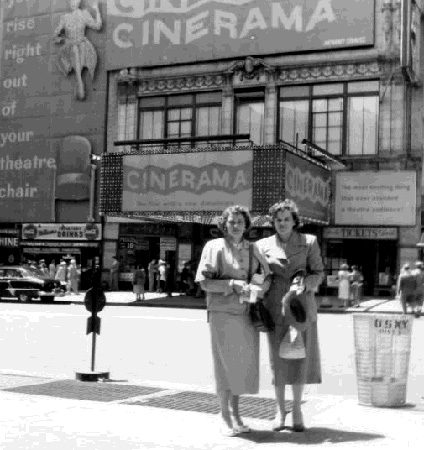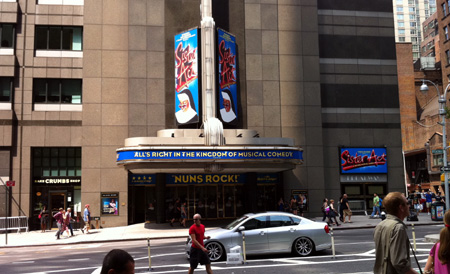Sound level in the Broadway Theatre |
Read more
at in70mm.com The 70mm Newsletter |
| Written by: Wentworth D Fling, Cinerama, Inc., December 10, 1952 | Date: 04.04.2010 |
 The
Broadway Theatre during "This is Cinerama". Image by Peter J.
Savasta, and borrowed from cineramahistory.com The
Broadway Theatre during "This is Cinerama". Image by Peter J.
Savasta, and borrowed from cineramahistory.com Since the opening of "This is Cinerama" in the Broadway Theatre, there has been a lot of discussion about whether the sound is too loud. People have asked me about this from time to time and I have received an occasional letter forwarded to me from the theater complaining about the sound being too loud. Recently Mr. Thomas sent me several letters on the same subject. From the technical point of view, there is one outstanding fact that influences the level at which the sound track for "This is Cinerama" should be played. For satisfactory reproduction, a sound track cannot be played at a lower level that at which the original performance was played when the recording was made. That is to say, that if an orchestra plays forte when the music should have been soft you cannot repair this damage by turning down the volume control on reproduction. All the detail and realism goes out of the music. It is completely artificial and dead. The reverse is almost equally true, of course. In stereophonic recording, with multiple microphones and multiple channels, it is especially difficult to do any "fixing up" with respect to the dynamics after the recording has been made. |
More
in 70mm reading: in70mm.com's Cinerama page Internet link: Roland Lataille's Cinerama Page The Letter: Cinerama, Inc. December 10, 1952 Memo to record Wentworth D Fling Sound level in the Broadway Theatre Messrs.: Lowell Thomas Hazard Reves Dudley Roberts Merian Cooper Robert Bendick William Latady Walter Thompson |
 Cinerama
sound mixing in Oyster Bay. Cinerama
sound mixing in Oyster Bay. Nearly all the music which was scored at the Tennis Court was "loud" in character. Crescendos and effects were created by going from loud to louder to loudest. In only a very few cases, notably the canoe ride through the trees in Florida and the Venice canals, was there any so-called "soft" music. To achieve any kind of satisfactory reproduction, we must create a sound level in the theatre at least equivalent to the sound level of the original performance when the recording was made. If we were to play back the recording made of the 375 voices of the Mormon Choir at a low enough level to satisfy those people who wrote in asking "why not soft music" or those who felt that the music should have been "soothing", the effect would be far less satisfactory than if we had recorded a quartet as the sound track for Western Air. The point I am trying to make is that we must differentiate between criticism of the sound track because some people would have preferred a different type of track (soft music - soothing) and criticism of the level at which a loud track is played. It was my feeling all during the scoring at Oyster Bay that the base dynamic level of the track was too high. Crescendos and effects could only be achieved by increasing the level. Of course, the character of the music in most cases required that it be loud. It was never written to be played in a soft and soothing manner. This quarrel cannot be taken up with the sound department. |
|
 The
Broadway Theatre 21.08.2011. Image by Bert Jansen The
Broadway Theatre 21.08.2011. Image by Bert JansenWe have from time to time experimented with lowering the level on certain passages in the theatre. The immediate effect, and it is very obvious, is that audience reaction drops way off. Some improvement might be accomplished in a re-mix job. But if we drop the rerecorded level of certain passages in order to achieve some relief from the continuous high level of the sound, there is no question but that will completely lose all realism and brilliance in these passages. |
|
 The
Broadway Theatre 21.08.2011. Image by Bert Jansen The
Broadway Theatre 21.08.2011. Image by Bert JansenIt is my opinion that unless we wish to re-score the whole picture, we should level well enough alone, and just make certain that in the future we recognize that there are different requirements in the recording of stereophonic sound and that it is all important that the proper dynamics be achieved in the original recording session. It goes without saying that this must be fully recognized when the writing of the score is undertaken and that many departures from present Hollywood techniques are required if the full value of stereophonic sound is to be realized. WDF:eml |
|
|
Go: back
- top - back issues
- news index Updated 21-01-24 |
|
